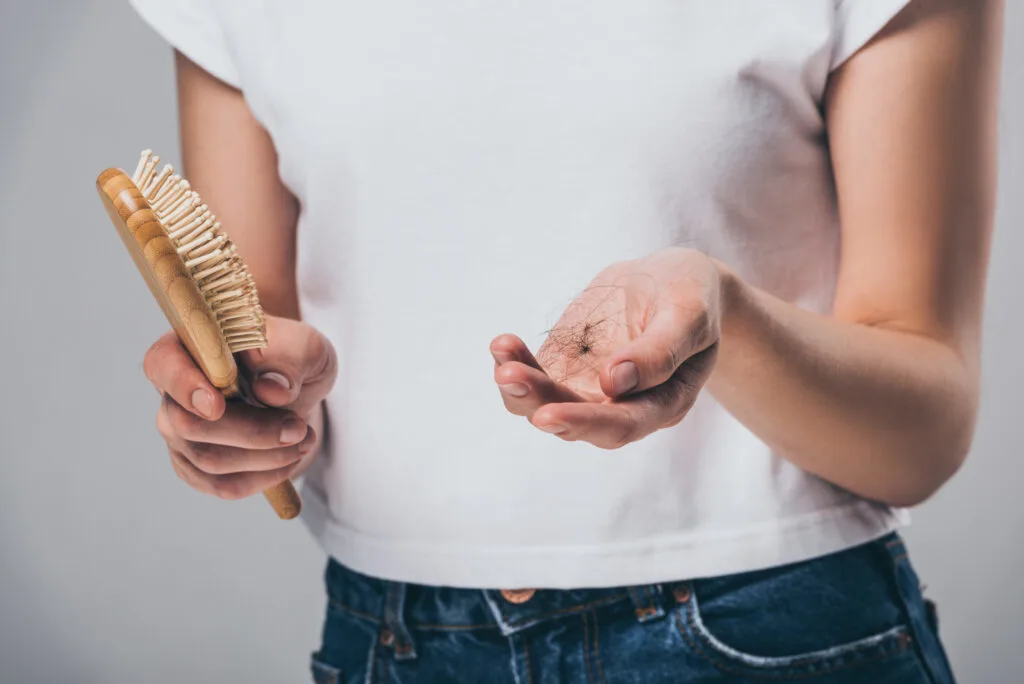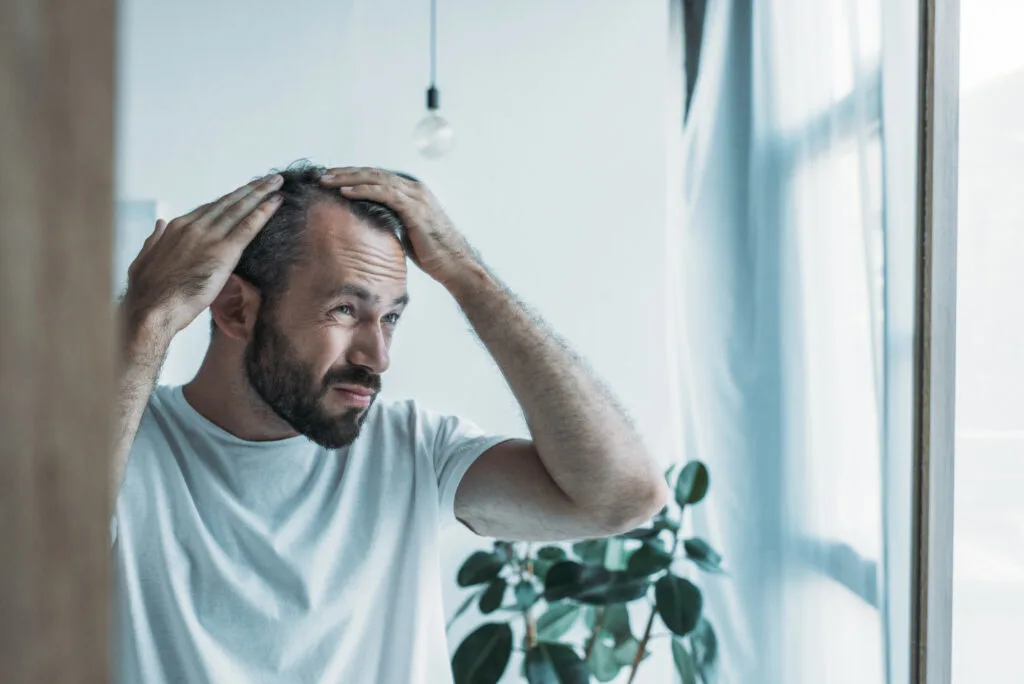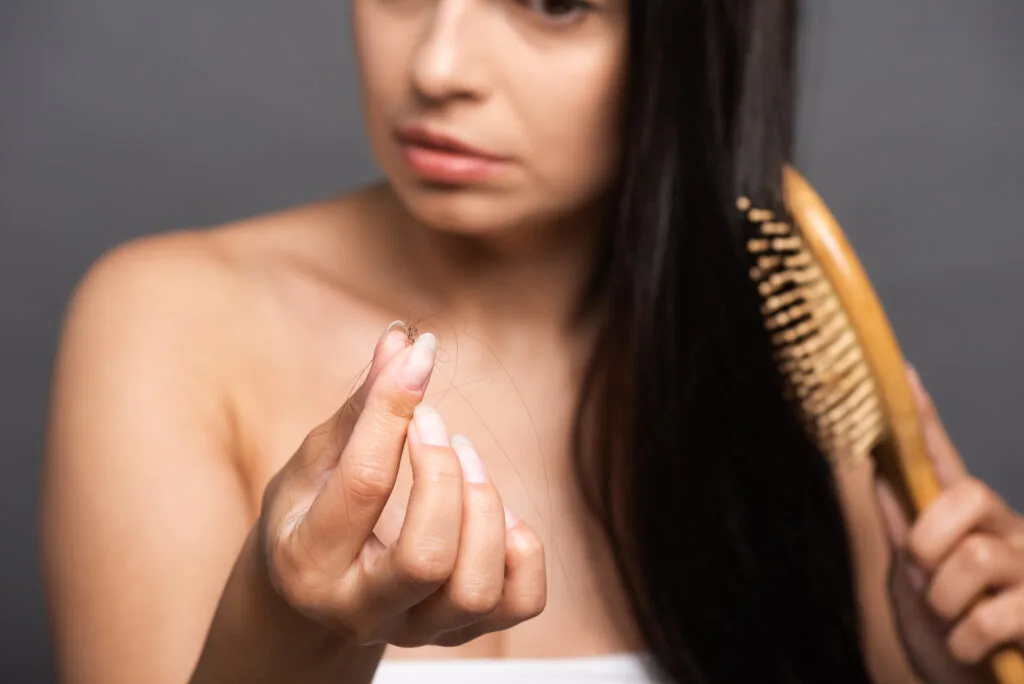If you are familiar with celebrities like Vin Diesel, Jason Statham or Dwayne Johnson, you will agree that baldness can be swoon-worthy! But not everyone feels so.
For some people, thinning of hair and balding can be quite overwhelming, especially when you are just in your 30s.
Hair loss can be frustrating and can take a toll on your self-confidence.
If you are facing hair loss in your 30s, you are not alone.
In fact, the American Hair Loss Association states that about 65% of men in the US begin to lose a notable amount of hair as they approach age thirty-five.
This article will answer all your questions about losing hair in your 30s and help you explore ways to reduce hair loss and boost hair growth.

A Little About Hair Loss:
According to the American Academy of Dermatologists, losing 50 to 100 strands of hair on a daily basis is absolutely normal. Hair loss is more noticeable in people who sport long hair.
Experts have also found that women are more prone to lose hair than men. It might be because they apply hair styling products and tools more frequently on their hair than men, which weakens the hair strands gradually.
Women also lose hair due to hormonal imbalances during pregnancy and menopause.
Multiple other factors play a role in excessive hair loss that contributes to balding. But before we dive into the different causes of hair loss, let’s take a look into the lifecycle of hair.
Lifecycle of Hair:
An infant is born with about 100,000 hair follicles on the scalp. The hair grown by each of the hair follicles lives up to two to five years.
Aging, nutrition, stress, personal hygiene, and hair products we apply to determine the number of hair we lose every day.
A hair strand goes through a three-phase life cycle:
The anagen phase, the first phase of the life cycle, is the growth phase of your hair.
At any time, 90% of all your hair is experiencing this phase. During this phase, the hair grows approximately one cm every month. If hair growth is inhibited during this phase due to any reason, it is called anagen effluvium.
During the second phase of the life cycle, the catagen phase, the hair follicles shrink, and hair growth slows down.
This “Transition” phase lasts for about 10-14 days. Finally, the telogen phase is the last phase of the life cycle of hair. It is a resting phase where the hair strands prepare themselves before shedding off from the scalp. Usually, about 8-9% of our total hair stays in this phase.
However, if more than 10% of our hair experiences this phase, it might lead to a hair loss disorder called telogen effluvium.
Causes of Hair Fall:
Everyone loses a few strands of hair every day. Usually, once a hair strand sheds off, new hair strands also grow from the hair follicles.
But, sometimes, hair follicles fail to produce new hair strands or the hair shedding increases. There are several common causes of hair loss which can cause excessive hair fall.
Stress is potentially the most common cause of excessive hair loss. Telogen effluvium (excessive hair shedding) can occur due to various reasons, such as:
- Excessive weight loss
- Post-partum (After giving birth)
- High fever
- Post-surgery
- While Recovering from a disease
- Medication side effects
- Chemotherapy
Another hair disorder, Anagen effluvium, happens when hair follicles fail to grow new hair.
It may happen due to various external and internal forces. The main causes for the impediment of hair growth can occur are:
- Genetics or Heredity of male-pattern baldness or male pattern hair loss
- Immune system overdrive
- Side effects of any treatment or drug
- Harsh hair products
- Compulsive pulling out of hair
- Chronic nutritional deficiencies
- Thyroid conditions
- Lupus
- Autoimmune diseases
Early Signs of Balding
While hair loss can be temporary, some types of hair loss can also be permanent.
Usually, signs of balding become notable during middle age. But this might vary from person to person. If you’re used to having a full head of hair and then start to notice you have less hair on your head but so much hair on your hair brush, you might feel unsettled.
Hair loss can begin at any age in adulthood. While some experiences excessive hair loss during their late teens and early 20s, others might lose hair beyond their 60s.
Typically, natural balding happens when you cross your 50s. However, pathological balding can happen at any time.
Signs of balding can also differ from person to person.
So let’s have a look at the signs that can help us recognize balding:
1. Thinning temples
Some people begin losing a noticeable amount of hair around their temples. Hair at the crown or the back of the head also becomes thin.
2. Receding hairline
A receding hairline means you begin to lose hair from the front and sides of the head. Thus, the hairline on your forehead moves further away from your face. Often, people start to exhibit an “M” shaped hairline because the hair from the side recedes away faster than the hair in the middle. Receding hairline is very common in males.
3. Thinning on the top of the head
For some people, the initial signs of balding are thinning of hair on the top of the head. The hair at the sides does not recede at all.
This type of hair loss may take years to show a bald area on the head. According to a 2012 study, this type of hair loss is pretty common in Asian males.

4. Widening part line
Some people may notice their part line (where your hair splits) widening when they experience hair loss.
5. Clumps of hair falling out
Sometimes, due to any intrinsic or extrinsic triggering factor, you may experience strikingly high hair loss and notice clumps of hair on your pillow or your hair brush or distinct bald areas.
This type of hair loss usually occurs due to underlying health conditions or as a side effect of certain medications. You may require professional help for such conditions.
6. Thinning across the scalp
Hair loss can also occur equally across your entire head. Hair thinning does not follow any specific shape or pattern. This type of hair loss is more likely to occur in females than males.
7. Losing body hair
Besides on your head, hair loss can also occur on different parts of your body. You may experience your body hair thinning or not growing back after your shave. Body hair loss can also occur due to aging.
Alopecia Areata: What You Should Know About It?
An autoimmune disease that causes hair loss, Alopecia Areata affects about 147 million people across the globe.
In this disorder, you may lose hair in small patches affecting small to wider areas on your scalp. Alopecia can affect almost anyone, irrespective of age, sex, or race.
However, most cases of Alopecia Areata develop in the 30s. If you lose hair on your scalp completely, it is called Alopecia Totalis. Losing hair throughout your body is termed Alopecia Universalis.
Alopecia Areata happens when the body’s immune system targets the hair follicles.
The leukocytes (white blood cells) attack the hair follicles, making them shrink and arresting new hair growth. However, scientists have not been able to find out why white blood cells attack hair follicles.
Some people think genetics might play a role in this disease.
Others think that extreme cases of stress could potentially trigger it. More research is needed in this field to understand what causes Alopecia Areata.

What are the Treatment Options for Hair Loss?
There are several treatment options. Make sure you discuss these with your primary care doctor or other medical professional before beginning use of them.
1. Minoxidil:
Minoxidil is an over-the-counter (OTC) drug that helps reduce hair loss and promote growth.
2. Spironolactone (Aldactone):
It is a prescription medication typically for women experiencing hair loss. This compound binds with the androgen hormone receptors and prevents hormonal imbalance.
3. Topical retinoids:
Topical retinoids, when applied on the scalp, help lengthen the Anagen phase and increase the rate of hair growth.
4. Hair transplant:
A hair transplant is a surgical procedure wherein hair follicles from a certain area of the body are transplanted to a bald spot.
Another similar treatment for hair loss is Follicular Unit Extraction.
It is also a surgical treatment when hair follicles are removed from a particular area and transplanted to an area where the hairline is receding.
5. Laser light therapy:
In this kind of therapy, photons are irradiated into scalp tissues to induce weak hair follicles to produce new hair and increase hair density on your scalp.
6. Prescription medications:
Certain medications like Finasteride and Dutasteride are often used to treat androgenic alopecia or male pattern baldness.
7. Platelet-rich plasma Treatment:
In this therapy, plasma-enriched platelets are injected into the blood to stimulate hair growth.
A clinical study showed that PRP treatment could boost moderate hair regrowth.
8. Stem cell therapy:
It is a novel therapy for hair loss that involves using an individual’s stem cells. Stem cells are implanted into hair follicles to boost the growth of new hair.

Frequently Asked Questions About Going Bald at 30:
1. Is it normal for women to lose hair in their 30s?
Hair loss can happen at any time. For a few women, hair loss can begin as early as their 20s and 30s.
The most common causes for women losing hair at such a young age are usually stress, hormonal changes, and dieting.
Even excessive use of heated hair styling tools and harsh cosmetic hair products can trigger hair loss. This type of hair loss is typically reversible.
2. Can vitamins reverse hair loss?
Nutritional deficiencies are one of the most common reasons for hair thinning.
A lack of protein and certain vitamins in your diet can weaken your hair follicles and arrest new hair growth. Adding high-protein food like eggs and fish oil can help boost hair growth.
Vitamins like Biotin (Vitamin B3) help revitalize the weakened hair follicles and help reverse hair loss.
Vitamin C supplements make your hair stronger and prevent premature hair fall.
Vitamin D is also essential for your hair’s health.
3. Can hair grow back after natural balding?
If your hair follicles have stopped producing hair due to aging or scarring, new hair will not grow any further from those follicles. However, if the hair follicles are healthy and intact, hair regrowth is possible.
Massaging with coconut oil or fish oil are popular home remedies to boost hair growth. Ingredients like aloe vera, ginseng, and onion juice can also be very beneficial for reversing hair loss.
Viviscal, a natural hair growth supplement, can also help reverse hair thinning. Essential oils like Rosemary oil and Geranium oil can also help with androgenetic alopecia.

4. Can women experience balding too?
Women usually do not show bald regions as they tend to have long hair. However, hair loss can lead to a reduction in hair volume.
Whereas bald men likely see a bald head of loss of facial hair, women might have different noticeable hair loss.
However, females might also experience pattern baldness like men due to androgenic alopecia. The first sign of alopecia in women is usually exhibited as a widening of the hair part line.
Women may also experience traction alopecia, a type of hair loss that occurs when a person frequently wears their hair in a specific manner.
The Bottom Line:
Hair loss is a slow process and may take several years to become noticeable. Balding in older ages is normal, but when you lose a strikingly high amount of hair in your 30s, it can be quite overwhelming. Usually, young people, both young men and women, lose hair due to stress, hormonal imbalances, or underlying medical conditions. However, this kind of hair loss can be reversed in most cases.
There are multiple home remedies that experts believe can help reduce hair thinning and boost hair growth. Some people may need specialized therapy or surgical treatment to have their hair grow back, such as Platelet-rich plasma therapy (PRP treatment), Follicular unit extraction, hair transplants, etc.
More Posts About Life In Your 30s
- Best 225+ Turning 30 Phrases, Wishes, Messages for a 30th Birthday
- 10 Things To Look Forward To In Your 30s
- 10 Best Blogs To Read In Your 30s
- 30 Books to Read In Your 30s
- 50 Inspiring Quotes For Your 30s
- The Ultimate Bucket List For Your 30s
- Turning 30 Poems: 30 Poems For 30th Birthday Wishes
- Turning 30 Humor and Turning 30 Jokes That Will Make You Laugh
- Cheers to 30 Years: How I’m Approaching My Thirties
- How To Deal With Overbearing Parents at 30
- 30th Birthday Party Themes: 36 Ideas To Celebrate in Style
- Gifts For Women In Their 30s
- How To Get My Life Together At 30
- How To Reinvent Yourself At 30
- 50 Movies Every Woman Should Watch In Her 30s
- 200+ Smile Quotes for Instagram to Inspire You
- 30 Great Gifts For Someone Turning 30
- How To Dress In Your 30s: 21 Must-Have Style Pieces
- Being In Your 30s: Everything You Need To Know
- 40 Hairstyles For Women In Their 30s
- Being Broke at 30: What To Do About It
- Starting Over In Your 30s: Where To Go From Here
